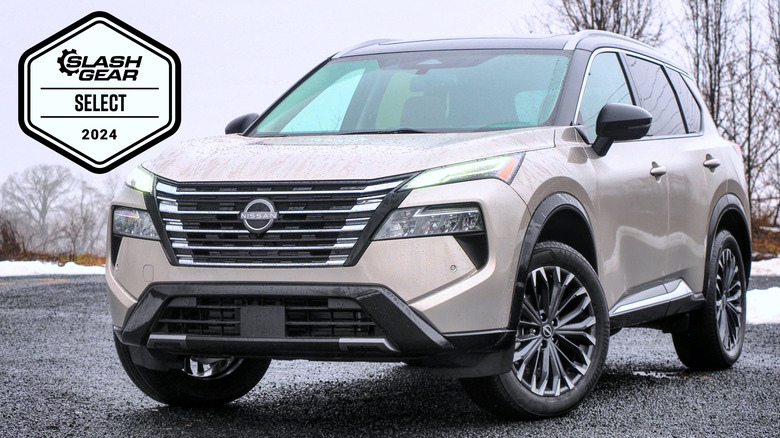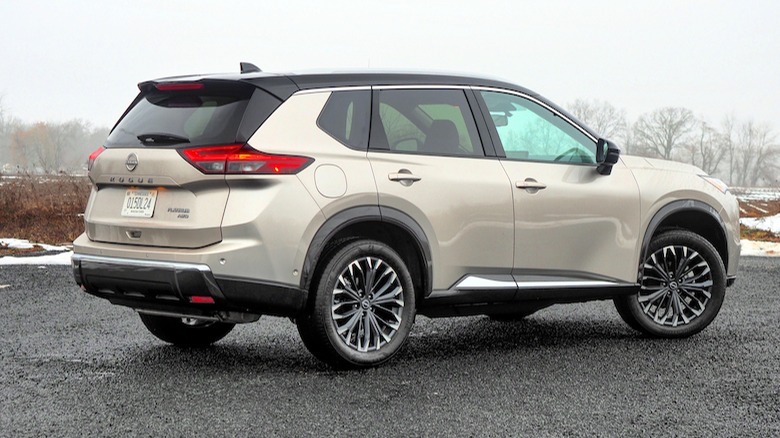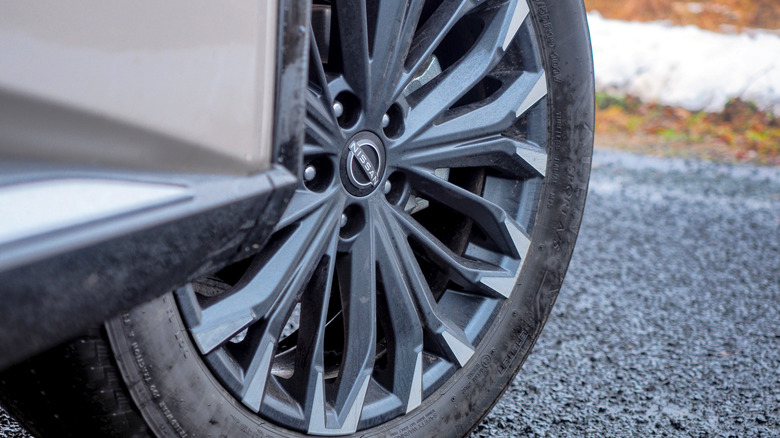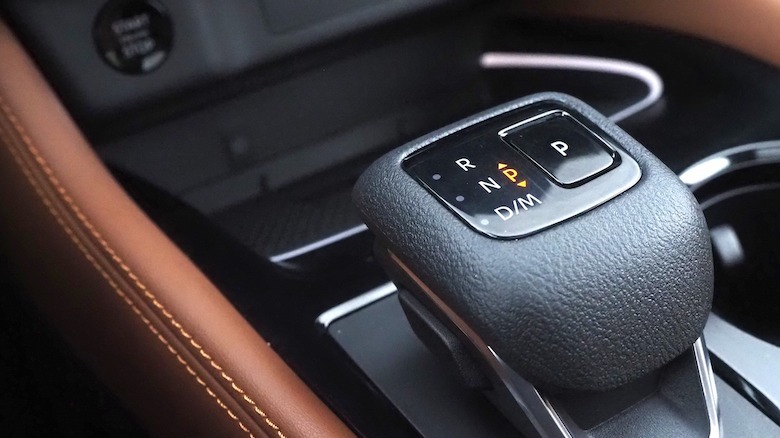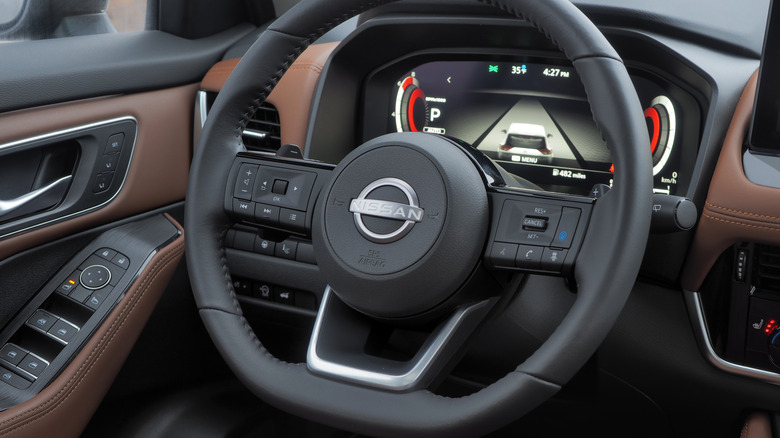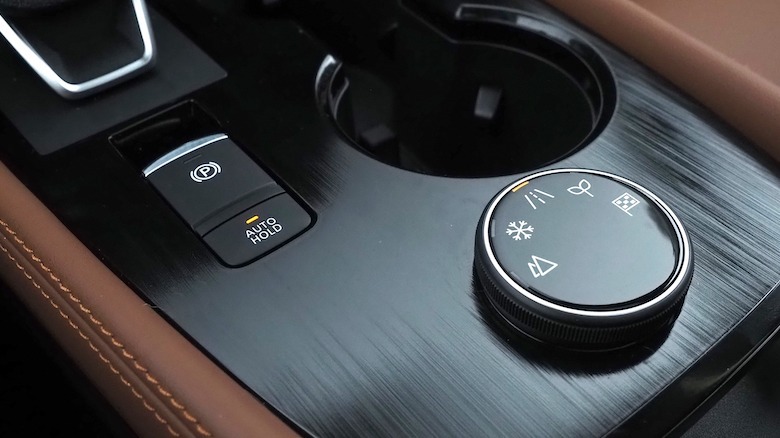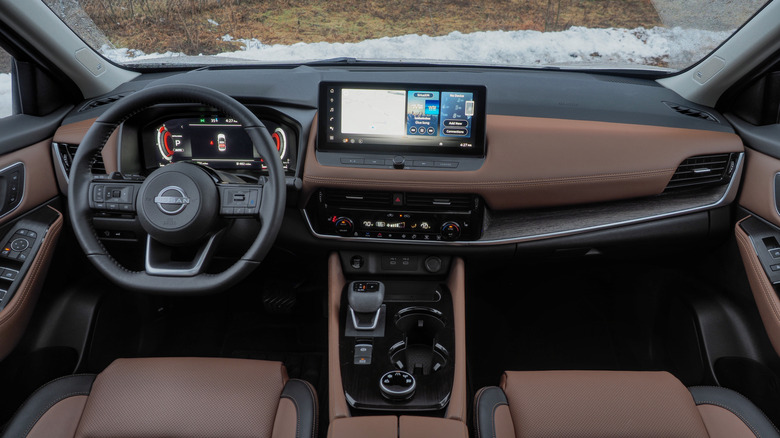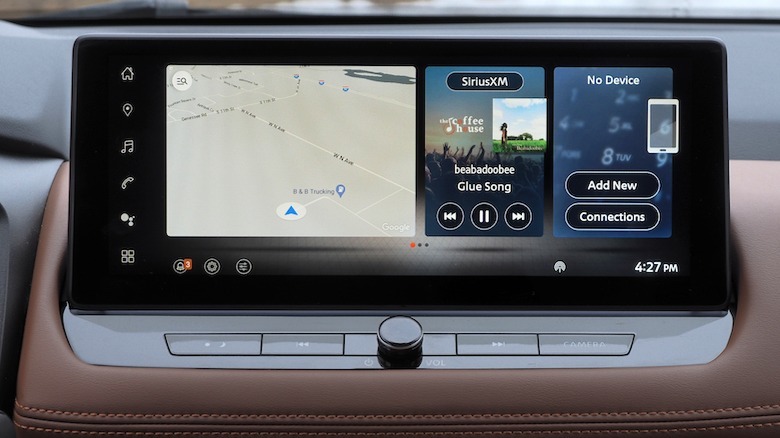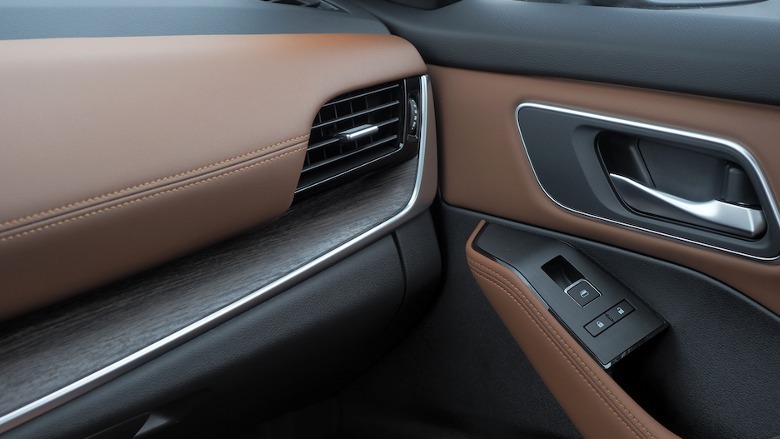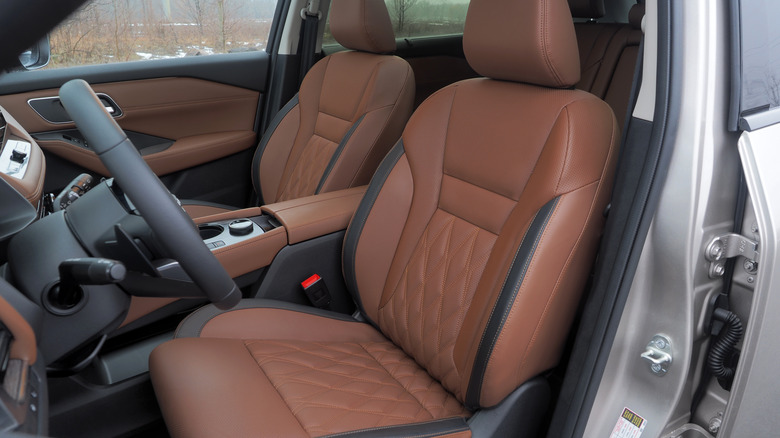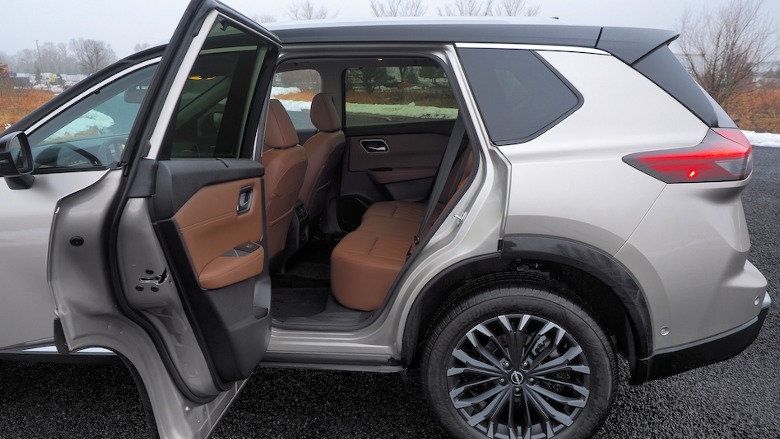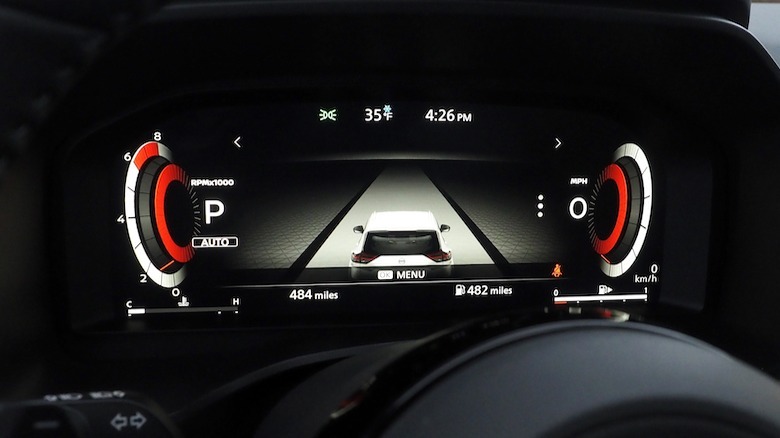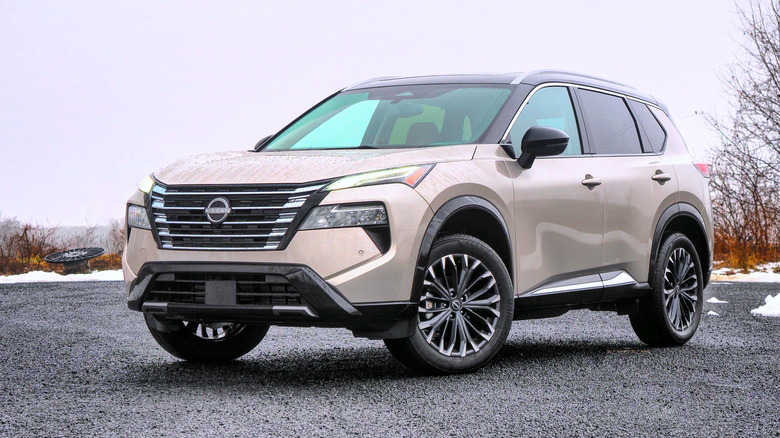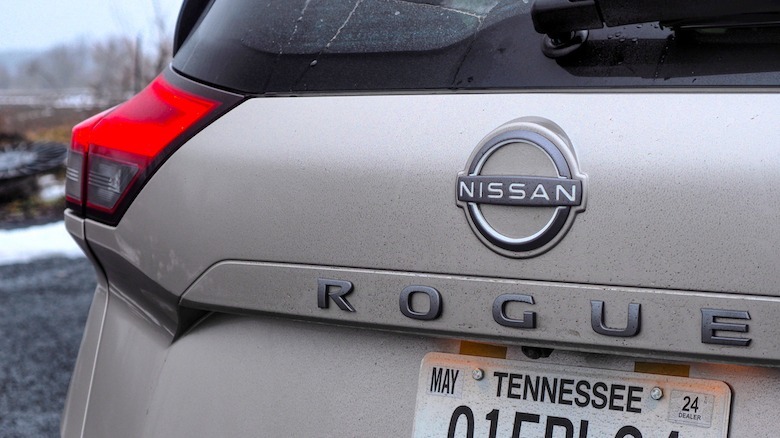2024 Nissan Rogue Review: Measuring Up To The Competition
- 1.5L turbo engine punches above its size
- Potential for strong fuel economy
- Handsome design
- Comfortable ride quality
- Lower trims feel miserly on specs
- This is not a sporty SUV
- Rivals have higher tow ratings
The 2024 Nissan Rogue's glow-up is an impressive one. Where the old SUV was a fairly unmemorable blob, this 2024 iteration borrows selectively from Nissan's bigger, burlier models., A larger, more imposing grille, fancier split-section lights, and a stronger shoulder line leave the crossover looking bigger than it actually is. The wraparound rear light clusters have been exaggerated, while stronger branding and a contrast black roof leave the whole thing feeling more confident.
As is often the way, bigger wheels help there. 17-inch examples come standard on the entry-level Rogue S, with 18-inch versions on the SV trim. The SL and this flagship Platinum spec model get (different) sets of 19-inch alloys.
All but the base trim get a power tailgate, heated side mirrors, and keyless entry. The Platinum trim gets a dual-panel moonroof as standard (it's optional on SV and SL). Nissan Safety Shield 360 is standard across the board, with rear automatic braking, blind spot warnings, rear cross-traffic alerts, lane departure warnings, high beam assist, and automatic emergency braking with pedestrian detection.
Skip the cheap one
Nissan's entry-level trim may start at just $28,420 (plus $1,390 destination) for the 2024 Rogue S FWD (with AWD a $1,500 upgrade), but you sacrifice a fair amount for that sub-$30k sticker. The Rogue SV (from $30,110 plus destination) seems like a worthy upgrade: it adds blind spot intervention, active lane-keep assist, and Nissan's ProPilot Assist hands-on adaptive cruise control with lane-centering.
The Rogue SL (from $35,270 plus destination) adds a 360-degree camera, front parking sensors to the standard rear ones, and upgrades to ProPilot Assist 1.1 that taps navigation data to automatically slow ahead of curves in the highway. The 2024 Rogue Platinum starts at $38,700 (plus destination) in front-wheel drive form.
All 2024 Rogue trims share the same engine, and it's not one you might expect if you're familiar with the U.S. SUV market. Nissan's turbocharged 1.5-liter gas engine has just three cylinders but still manages to deliver 201 horsepower and 225 lb-ft of torque. That's more torque than either of the 2.5-liter non-turbo inline-four examples in Hyundai's 2024 Tucson or Toyota's 2024 RAV4 and more horses than the Tucson.
Peppy but not exactly fun
One of the advantages to a smaller engine is smaller thirst. In all-wheel drive form, the Rogue is EPA estimated (finalized figures aren't available at time of publication) at up to 28 mpg in the city, 35 mpg on the highway (or 34 mpg for the Platinum trim), and 31 mpg combined. The front-wheel drive version promises to do even better, at 30 mpg, 37 mpg, and 33 mpg respectively for city, highway, and combined driving.
On the road, the Rogue is peppy but doesn't exactly encourage aggressive driving (though neither, frankly, does the Hyundai or the Toyota, or most of the competitive crossover set). The standard continuously-variable transmission is a good match for the 1.5 turbo, blending into the background. Firm but not uncomfortable suspension, along with steering tuned on the light side, avoid wallow.
Twisting the drive mode knob to Sport doesn't awaken a sporting dragon, but leaves the Nissan a little more urgent when you hit the gas. Just be aware that the Rogue's impressive economy numbers are very much based on the idea of you resisting that urge.
Two tiers of tech
With a spacious cabin — including rear doors that open particularly wide, great if you're dealing with child seats — plus 36.5 cu-ft of trunk space with the rear bench up and 74.1 cu-ft of it with the seats folded, the Rogue isn't a bad place to amble along inside, though. Leather comes standard on the SL trim, with the Platinum switching to fancier quilted semi-aniline hide; both trims also get a leather-wrapped steering wheel. S and SV trims have an 8-inch infotainment touchscreen with wired Apple CarPlay and Android Auto support.
SL and Platinum swap that out for a 12.3-inch version with navigation, Amazon Alexa, and wireless smartphone projection, and the Platinum enjoys a 10-speaker Bose audio upgrade, too. You're getting more than just a bigger touchscreen, though (along with a 12.3-inch fully digital instrument cluster). Nissan's bigger infotainment screen runs Google Built-In, with Google Maps, Google Assistant, and Google Play store access.
Device support is another reason to skip the relatively bare-bones S trim: the more expensive versions double its mere two USB ports, as well as adding WiFi hotspot support (with an optional subscription). SL and Platinum get a wireless phone charging pad in the front center console.
A classy cabin, but some omissions
Even loaded up with all the toys Nissan offers, there's a welcome simplicity to the Rogue's cabin. Part of that is an admirable degree of design restraint: the sweep of wood, metal, and soft-touch faux leather looks clean and feels premium, reminiscent of Mazda's excellent interiors. There are physical controls for the HVAC and multimedia, but they're neither comically outsized nor over-styled nor confusingly convoluted and needlessly numerous. Nissan doesn't hide the things you'll want most frequently, like drive mode adjustment or USB ports.
It's not an entirely clean sweep, mind. When it's up and running, the Google-based infotainment is fast and responsive, but on several occasions, it took a good 20-30 seconds before anything appeared on the screen after starting the Rogue up. That also meant the reversing camera simply didn't appear.
Then there's the absence of features like ProPilot Assist 2.0, Nissan's hands-off Level 2 driver assistance package. That, like ProPilot Assist 1.1, promises to keep you centered in the lane and at pace with the traffic ahead but relies on a driver-monitoring camera to ensure you're paying sufficient attention: as a result, you're allowed to take your hands off the wheel. It's offered on the Nissan Ariya EV but not on the Rogue.
2024 Nissan Rogue Verdict
The absence of things like ProPilot Assist 2.0 matters because compact crossover buyers are spoiled for choice now. Long gone are the days when a big trunk and spacious back seat were enough to guarantee success. Small SUVs need to stand out, as well as nail the basics, even if they're not demanding luxury price tags.
On that front, the 2024 Rogue is a mixed bag. The spec of the entry-level S trim feels miserly, a calculated play so that the automaker can continue to advertise a sub-$30k starting price. Meanwhile, in top-tier Platinum trim, it certainly checks off plenty of the creature comfort boxes, but it's not as engaging to drive as rivals, even if its relatively diminutive engine can compete on power. Better altogether, then, to settle into a more affordable Rogue SV or SL and simply cruise, at which point Nissan's strong economy numbers play their hand.
